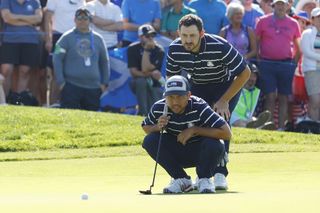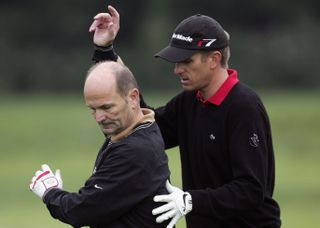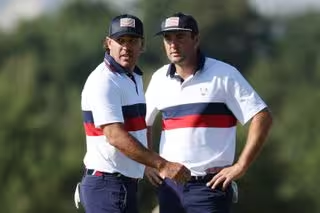Many golfers refer to anyone they are playing with as their ‘partners’ for that round. This, in many senses, is understandable for they are, indeed, the people who are partnering you for your time out on the course during that particular round.
But it’s probably better to use a different word or term if possible (‘fellow players’, ‘others in my group’) as the word ‘partner’ means something very specific in the Rules of Golf and you need to know who is really your ‘partner’ out on the course when it comes to certain Rules.
As ever, the first port of call should be the Definitions section at the end of the Rule book and, thankfully, on this occasion, the definition is very concise…
A ‘partner’ is “a player who competes together with another player as a side, in either match play or stroke play”.
Brooks Koepka and Scottie Scheffler as Ryder Cup partners
(Image credit: Getty Images)
So, in your typical club medal or Stableford three-ball, the two others playing with you are not your ‘partners’ even though they are ‘partnering’ you for that round in the broader sense of the word.
Why does it matter? Well, there are various things that a ‘partner’ can do that others you are playing with, who are not your ‘partner’, cannot. Perhaps the most obvious is Rule 10.2, which covers advice. After detailing various things that constitute ‘advice’ and explaining what it is prohibited, a note at the end of Rule 10.2a then says…
“See Rules 22, 23 and 24 (in forms of play involving partners, a player may give advice to their partner or partner’s caddie and may ask their partner or partner’s caddie for advice).”

‘Partners’ can confer on the line of putt or other shots, while those you are merely ‘playing with’ cannot
(Image credit: Getty Images)
In other words, your ‘partner’ can tell you what club they’ve just hit or advise you on what club to hit, what kind of shot to play and how to play it – all the things that would incur penalties if they were not your ‘partner’.

Swing tips and advice are fine if the other player is your ‘partner’, but not if they are not
(Image credit: Getty Images)
Various other Rules conclude with this footnote, too…
“See Rule 22.2 (in Foursomes, either partner may act for the side and action by the…
..
Click Here to Read the Full Original Article at Golf Monthly…
